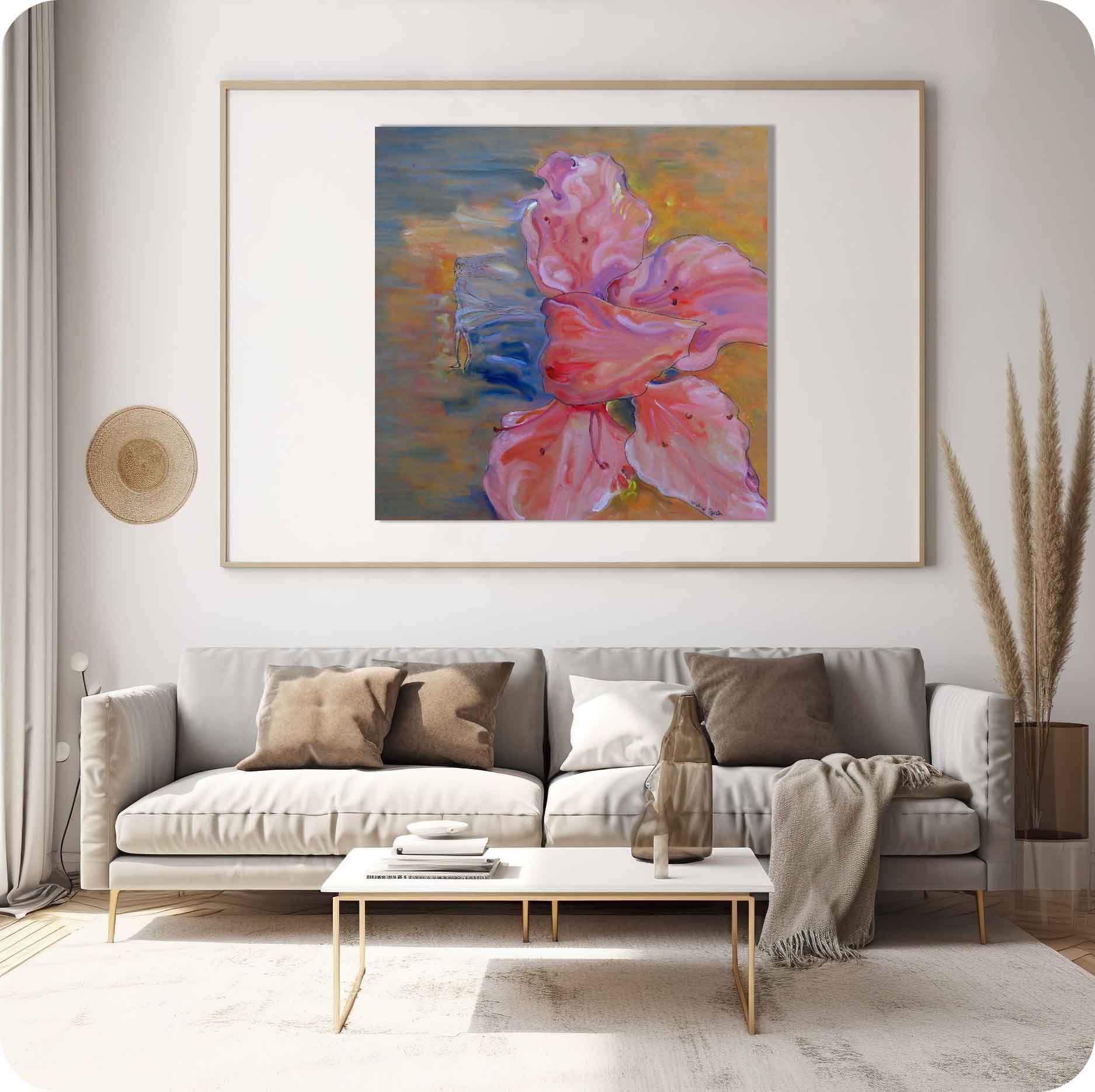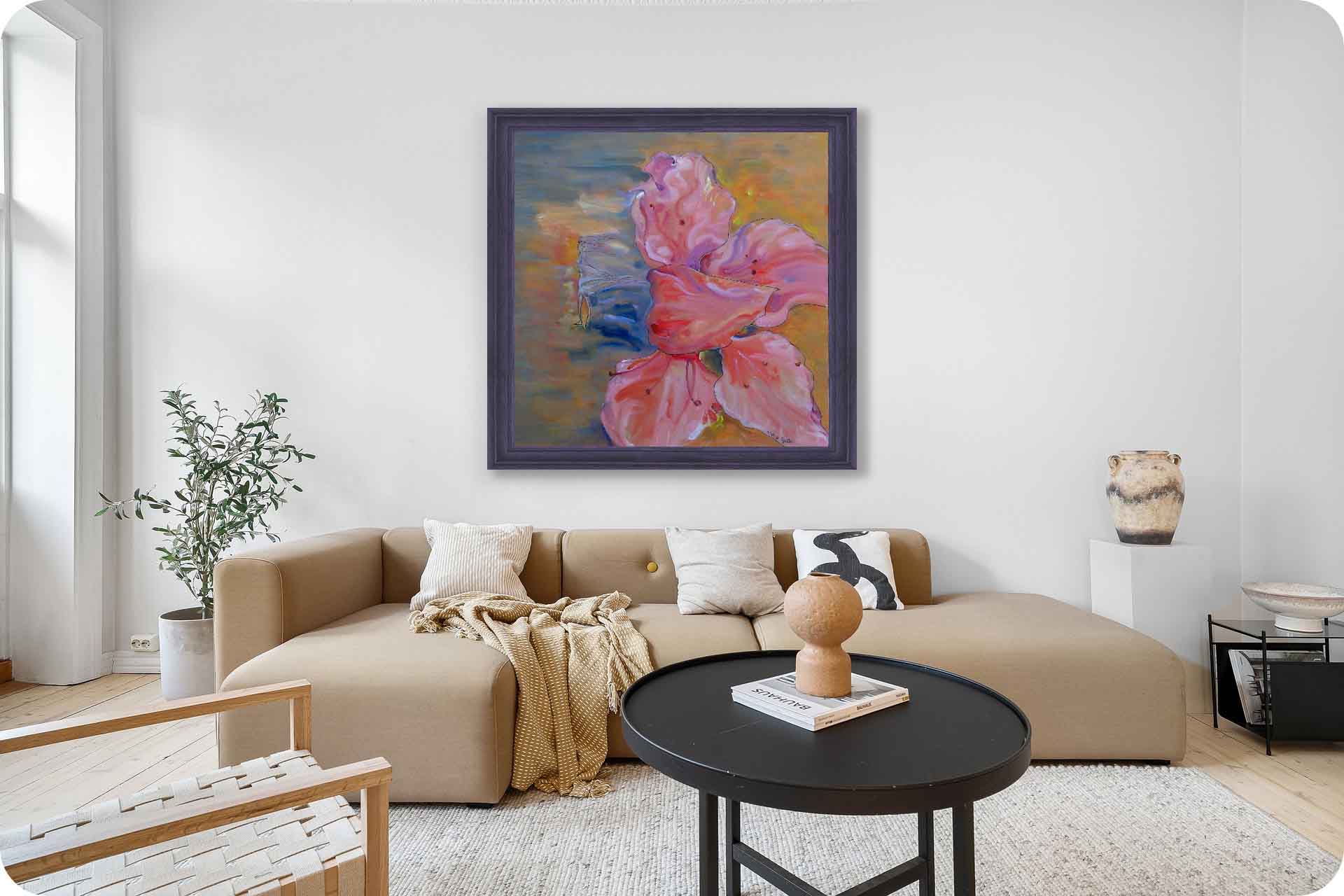The theme of this year's painting clearly states one - the makeup of desire. People's various desires are wrapped under various makeups. Desires are the intertwining of happiness and pain in life. Either straightforward or subtle, they will appear in makeup, forming a profound look of an era.
If spring is compared to a person, then beauty is the desire of spring, desire is the action of "loneliness", and flowers are the makeup of "desire".
Inches: 23.6 x 23.6 in
Size without the frame: 60 x 60 cm
Country: China
Date: 2024
Materials: Acrylic paint on linen
Condition: well preserved
Creative themes and style | My works revolve around the creative concept of "The land of humanity, People on the land".The people in the painting are people in nature, and the lines, shapes, and colors are close to nature. The nature in the painting is nature in the eyes of humans, existing in interaction with humans.I don’t pursue a series of works with a fixed and continuous style. I hope that the style of the pictures will synchronize with the changes in my life and always remain oscillating. The performance of the work must be in sync with the development of one's own life in order to be Sincere and powerful.Ideas are later.
An Interview with Artist Philo by Artphiloso Gallery
If you would like to collect this artwork or know more about the artist, please contact us.
living room paintings,living room wall images,modern wall decor for living room,unique wall decor for living room,wall art for living room modern.


1. Subject and Composition
At the center of this painting is a blooming pink flower, rendered with luminous petals that unfold in layers of pink and violet. Through color blending, the petals reveal subtle gradients, echoing the shifting play of spring light and shadow. The use of a black outline enhances structural clarity, anchoring the flower visually against the hazy, dreamlike background. The flower thus becomes both the focal point of the composition and the symbolic heart of the work.
2. Surreal Elements and Symbolism
To the left of the flower, a faintly sketched human-shaped fairy emerges, its figure drawn with delicate lines. This semi-transparent presence contrasts with the flower’s solidity, serving as a surreal symbol of inner solitude. The interplay between the fairy’s ghostlike lightness and the flower’s grounded form evokes the projection of a lonely soul—one that exists even amidst beauty, maintaining a fragile distance from the noisy, external world.
Here, loneliness is not depicted as despair but is transformed into a romantic interpretation: a unique posture of the soul, poised between withdrawal and communication, between isolation and coexistence.
3. Color Dynamics and Atmosphere
The background is suffused with warm yellows interwoven with blue-purple tones, creating a dreamlike yet distant atmosphere. This chromatic interplay establishes visual tension with the flower’s vibrant brightness, reinforcing the paradox of “loneliness within liveliness.”
By employing symbolist techniques, the artist transforms a flower into more than a natural object; it becomes a vessel through which abstract loneliness is visualized. Each petal’s gradient and each line tracing the fairy embodies the exploration of emotional coexistence, offering viewers a way to penetrate beyond surface beauty and engage with the hidden dialogue between the soul’s solitude and the world’s noise.
4. Emotional Projection and Style
The painting resonates with both Romanticism and Symbolism, where visible forms are infused with inner emotions. The flower radiates life, yet the presence of the faint figure introduces a pause, a reminder of distance within abundance.
Through this contrast, the painting communicates how art can translate emotions into imagery—transforming solitude into a poetic aesthetic experience. The work positions loneliness not as emptiness, but as a state of self-awareness and inner communication, offering viewers a profound meditation on spring’s dualities of vitality and silence.
Zhou Chunya’s Green Dog
With exaggerated colors and unrestrained brushstrokes, Zhou turns an animal into a symbol of individuality. Similarly, this painting employs bold contrasts and expressive techniques to highlight inner emotion.
Xu Lei’s Imaginary Stone
Using delicate lines and blending tradition with modern fantasy, Xu constructs dreamlike illusions. This resonates with the transparent fairy figure in this painting, which fuses delicacy with surreal imagination.
Georgia O’Keeffe’s Poppy
By magnifying floral forms and applying soft tonal transitions, O’Keeffe captures vitality and sensuality. Likewise, this painting emphasizes the intimate vitality of the flower, using detail and softness to heighten emotional impact.
René Magritte’s Man with a Black Hat
Magritte employs surreal composition to challenge conventional perception. This painting echoes that approach through its juxtaposition of realistic blossoms with a surreal companion figure, breaking ordinary visual logic and inviting symbolic interpretation.
This painting is a Romantic-Symbolist meditation on solitude and vitality. Through color contrasts, surreal symbolism, and poetic transformation, the artist redefines loneliness as not merely absence, but as an aesthetic state of inner dialogue and emotional coexistence. The result is a work that merges the tenderness of spring’s vitality with the stillness of the soul, offering a deeply resonant visual experience.
The painting places the flower slightly to the right of the canvas, with its petals fully extended, becoming the main visual focal point. On the left side, negative space is intentionally left open for the interaction between the figure and the background. This kind of asymmetrical composition breaks away from the balance of traditional floral paintings, giving the artwork stronger tension and a sense of narrative depth.
The background shifts through gradients of gold, ochre, and blue, evoking a mood that feels somewhere between sunset and dreamscape. The collision of warm and cool tones, combined with the flower’s delicate pink petals, creates a mood that is both romantic and slightly mysterious, as if telling a story suspended between reality and imagination.
The relationship between the petals and the figure adds a layer of narrative to the piece: the petals seem to open like an embrace, while the figure on the left appears either to be conversing with the flower or drawn toward it. This arrangement not only gives the painting symbolic meaning, but also encourages viewers to engage in personal interpretation, naturally projecting their own imagination into the scene.
As a piece of “contemporary surreal floral wall art décor”, this painting is perfectly suited for intimate and atmospheric interiors—such as a study, bedroom, or boutique hotel that seeks to create an immersive ambiance. It adds both poetry and imagination to the space, serving as a striking centerpiece that enhances the overall mood.
This work belongs to the category of “original hand-painted floral art collectibles” in today’s art market. Its unique color treatment and narrative composition highlight the artist’s creativity, making it valuable as both a contemporary art collectible and an investment piece. Not only can it enrich a personal art collection, but it also carries strong long-term appreciation potential.
A: Click here to view ARTPHILOSO's Guide for Collectors.
More paintings from this series:
Symptoms of loneliness in spring 1 Symptoms of loneliness in spring 2
Symptoms of loneliness in spring 3 Symptoms of loneliness in spring 4
Symptoms of loneliness in spring 5
Symptoms of loneliness in spring 7 Symptoms of loneliness in spring 9
